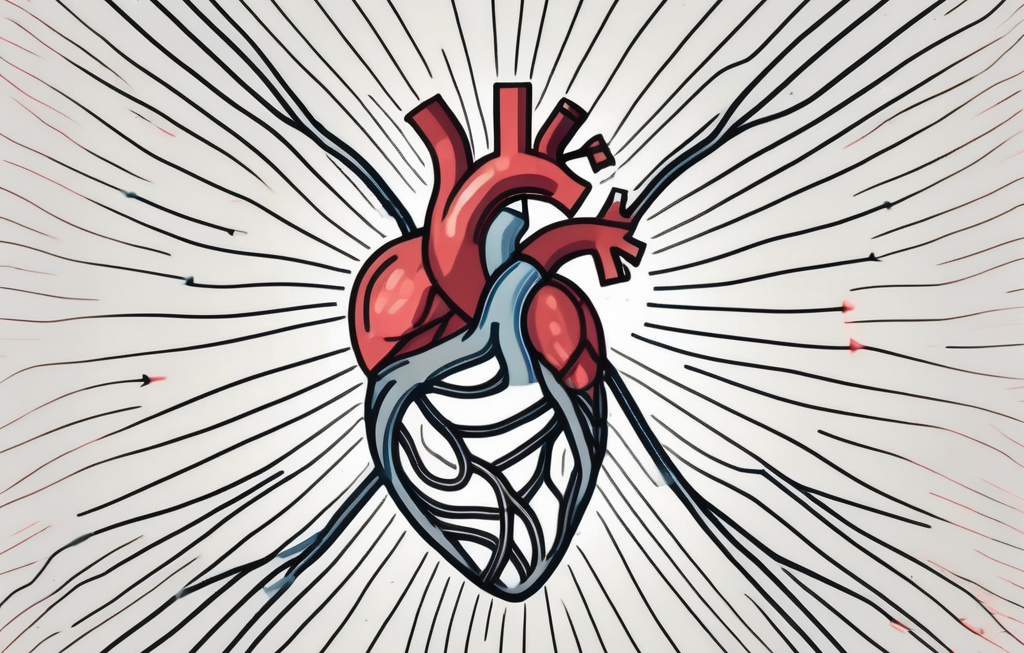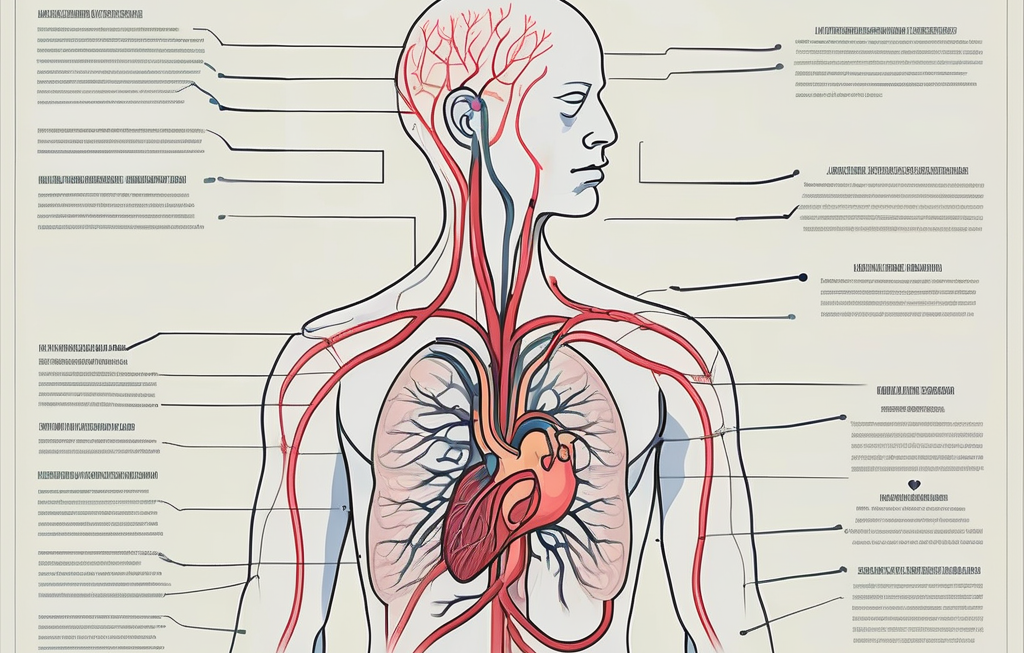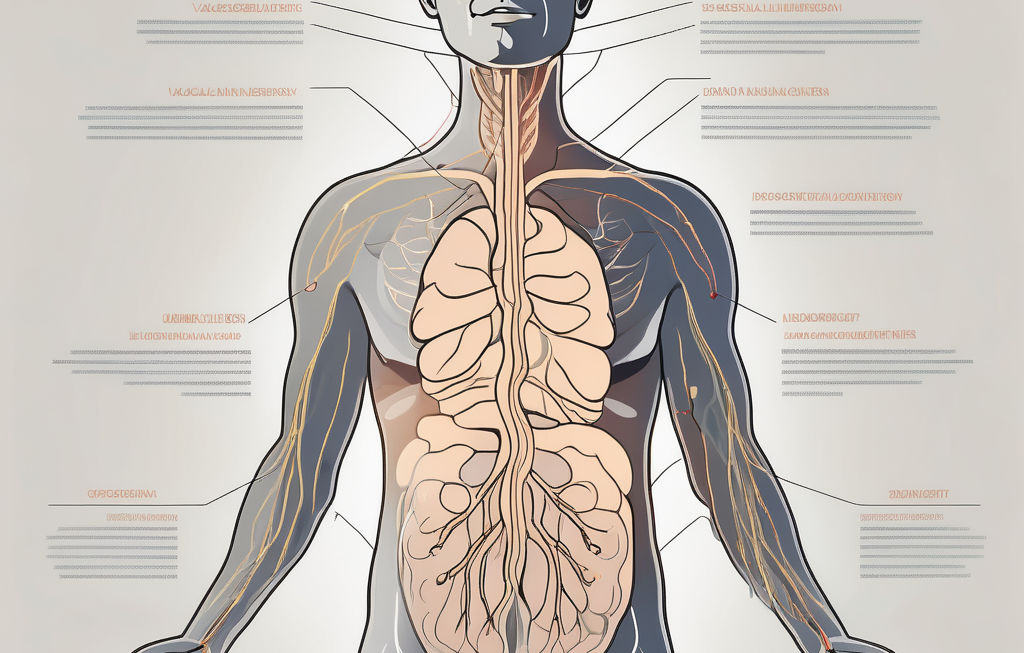Cardiac vagal activity refers to the functioning of the vagus nerve in regulating heart rate and overall heart health. The vagus nerve is a major component of the parasympathetic branch of the autonomic nervous system, which is responsible for regulating involuntary bodily functions. Understanding the basics of cardiac vagal activity is crucial for comprehending the role it plays in maintaining cardiovascular well-being and how it can be measured and improved.
Understanding the Basics of Cardiac Vagal Activity
The Role of the Vagus Nerve in the Cardiovascular System
The vagus nerve, also known as the tenth cranial nerve, is a vital communication pathway between the brain and various organs, including the heart. Its primary function is to maintain homeostasis and regulate the body’s internal organs. In the cardiovascular system, the vagus nerve plays a crucial role in reducing heart rate and promoting relaxation.
The vagus nerve releases the neurotransmitter acetylcholine, which binds to specific receptors on heart cells, causing a decrease in heart rate and cardiac output. This parasympathetic response is often referred to as the “rest and digest” response, in contrast to the sympathetic “fight or flight” response.
The Biological Mechanisms of Cardiac Vagal Activity
To understand cardiac vagal activity, it is important to grasp the underlying biological mechanisms. When the vagus nerve is activated, it releases acetylcholine, which binds to specific receptors called muscarinic receptors on the heart cells. This binding triggers a cascade of events that lead to a decrease in heart rate and overall heart activity.
Additionally, the vagus nerve plays a role in modulating heart rate variability (HRV), which refers to the variation in the time intervals between successive heartbeats. Higher HRV is generally associated with better cardiovascular health as it reflects the adaptability and resilience of the cardiovascular system.
Furthermore, recent research has shown that cardiac vagal activity is not only involved in regulating heart rate but also in influencing other physiological processes. For instance, studies have demonstrated that increased vagal activity is associated with improved digestion and gastrointestinal motility. This suggests that the vagus nerve’s impact extends beyond the cardiovascular system, highlighting its multifaceted role in maintaining overall bodily function.
Moreover, the vagus nerve has been found to play a crucial role in the body’s stress response. When activated, it can help dampen the body’s stress response by reducing the release of stress hormones, such as cortisol. This mechanism is essential for preventing chronic stress and its detrimental effects on the cardiovascular system.
The Importance of Cardiac Vagal Activity
How Cardiac Vagal Activity Affects Heart Health
Optimal cardiac vagal activity is crucial for cardiovascular health. Research has shown that individuals with higher resting heart rate variability, indicating greater cardiac vagal activity, are at a lower risk of developing cardiovascular diseases, such as hypertension, coronary artery disease, and heart failure.
Cardiac vagal activity helps maintain the balance between the parasympathetic and sympathetic branches of the autonomic nervous system. This balance is essential for regulating heart rate, reducing inflammation, and promoting overall heart health.
Furthermore, studies have indicated that individuals with higher cardiac vagal activity may also experience improved emotional regulation and better stress management. This is because the vagus nerve, a key component of the parasympathetic nervous system, plays a crucial role in regulating emotions and promoting feelings of calmness and relaxation.
The Connection between Cardiac Vagal Activity and Stress Response
Stress has a significant impact on cardiac vagal activity. During periods of acute stress, the body’s sympathetic nervous system becomes dominant, leading to an increase in heart rate and blood pressure. In contrast, chronic stress can negatively impact cardiac vagal activity and increase the risk of cardiovascular diseases.
Understanding and managing stress is crucial for promoting optimal cardiac vagal activity. Various stress reduction techniques, such as mindfulness meditation, deep breathing exercises, and regular physical activity, can help enhance cardiac vagal activity and support heart health.
Measuring Cardiac Vagal Activity
Techniques for Assessing Cardiac Vagal Activity
Several techniques can be used to measure cardiac vagal activity. One commonly used method is heart rate variability analysis, which involves examining the variations in the time intervals between successive heartbeats. This analysis provides insights into the functioning of the autonomic nervous system, including cardiac vagal activity.
Heart rate variability analysis is a non-invasive technique that can be performed using specialized software and equipment. By analyzing the patterns of beat-to-beat intervals, researchers and healthcare professionals can gain valuable information about the balance between sympathetic and parasympathetic nervous system activity. This information can be particularly useful in assessing the cardiovascular health of individuals, as well as their response to stress and various physiological conditions.
Another method for assessing cardiac vagal activity is through respiratory sinus arrhythmia. This technique measures heart rate changes in response to breathing patterns. As individuals inhale and exhale, the heart rate naturally fluctuates due to the influence of the vagus nerve. By analyzing these fluctuations, researchers can estimate the level of vagal tone, which is an indicator of cardiac vagal activity.
Electrocardiography (ECG) is another valuable tool for evaluating cardiac vagal activity. This technique involves placing electrodes on the chest to record the electrical signals generated by the heart. By analyzing the ECG waveform, healthcare professionals can assess various parameters, such as heart rate, heart rate variability, and the presence of any abnormal cardiac rhythms. These parameters provide valuable insights into the functioning of the autonomic nervous system, including cardiac vagal activity.
Interpreting Results of Cardiac Vagal Activity Measurements
Interpreting the results of cardiac vagal activity measurements requires expertise and knowledge. Assessing heart rate variability parameters, such as high-frequency power and the ratio of low-frequency to high-frequency power, can provide insights into the state of cardiac vagal activity. Additionally, comparing measurements across different physiological conditions and populations is essential to draw meaningful conclusions.
It is important to note that any interpretation of cardiac vagal activity measurements should be done in consultation with healthcare professionals or experts in the field. They can provide a comprehensive analysis and guide individuals towards appropriate interventions if necessary.
Furthermore, it is crucial to consider individual differences and potential confounding factors when interpreting cardiac vagal activity measurements. Factors such as age, gender, medication use, and underlying health conditions can influence the results. Therefore, a thorough understanding of the individual’s medical history and context is essential for accurate interpretation.
Overall, measuring cardiac vagal activity through techniques like heart rate variability analysis, respiratory sinus arrhythmia, and electrocardiography provides valuable insights into the functioning of the autonomic nervous system. These measurements can aid in the assessment of cardiovascular health, stress response, and the effectiveness of interventions aimed at improving cardiac vagal activity. With the guidance of healthcare professionals, individuals can gain a deeper understanding of their physiological state and take proactive steps towards optimizing their well-being.
Factors Influencing Cardiac Vagal Activity
Lifestyle Factors and Cardiac Vagal Activity
Several lifestyle factors can influence cardiac vagal activity. Regular physical activity, adequate sleep, and a healthy diet rich in fruits, vegetables, and whole grains have been associated with higher cardiac vagal activity. On the other hand, sedentary behavior, poor sleep quality, and unhealthy dietary habits may negatively impact cardiac vagal activity.
Reducing stress levels through stress management techniques, such as relaxation exercises and engaging in activities that promote emotional well-being, can also enhance cardiac vagal activity.
Moreover, incorporating mindfulness practices like meditation and yoga into one’s daily routine has shown promising results in boosting cardiac vagal activity. These practices not only help in reducing stress but also improve overall heart health and autonomic nervous system function.
Medical Conditions and Their Impact on Cardiac Vagal Activity
Certain medical conditions can affect cardiac vagal activity. Conditions such as heart disease, diabetes, and autonomic neuropathy can lead to decreased cardiac vagal activity and increased risk of cardiovascular complications. Additionally, mental health disorders, such as depression and anxiety, have also been linked to alterations in cardiac vagal activity.
In these cases, it is crucial to work closely with healthcare professionals who can provide appropriate medical interventions and guide individuals towards improving their cardiac vagal activity in a safe and effective manner.
Furthermore, research has shown that regular cardiovascular exercise can help in restoring cardiac vagal activity in individuals with compromised heart health. Exercise not only strengthens the heart muscle but also enhances the function of the autonomic nervous system, leading to improved cardiac vagal tone and overall cardiovascular health.
Improving Cardiac Vagal Activity
Strategies for Enhancing Cardiac Vagal Activity
Improving cardiac vagal activity can have significant benefits for heart health. Engaging in regular physical activity, such as aerobic exercises, has been shown to enhance cardiac vagal activity. Activities like yoga and tai chi, which incorporate deep breathing and relaxation techniques, are also effective in promoting optimal cardiac vagal activity.
Furthermore, incorporating mindfulness practices into your daily routine can have a profound impact on cardiac vagal activity. Mindfulness meditation, a practice that involves focusing on the present moment without judgment, has been linked to increased heart rate variability and improved parasympathetic function. By cultivating mindfulness, individuals can better regulate their autonomic nervous system, leading to enhanced cardiac vagal activity.
Additionally, stress management techniques, including mindfulness meditation, deep breathing exercises, and engaging in hobbies or activities that promote relaxation, can help improve cardiac vagal activity.
The Role of Exercise and Diet in Boosting Cardiac Vagal Activity
Exercise and diet are two important factors in boosting cardiac vagal activity. Regular aerobic exercise, such as jogging, swimming, or cycling, has been shown to increase heart rate variability and enhance parasympathetic activity. A well-balanced diet, with a focus on whole foods and an adequate intake of nutrients, can also support optimal cardiac vagal activity.
Moreover, the relationship between exercise and cardiac vagal activity is multifaceted. Not only does physical activity directly impact vagal tone, but it also contributes to overall cardiovascular health, which in turn can positively influence autonomic function. Similarly, a nutrient-rich diet plays a crucial role in supporting the body’s physiological processes, including the regulation of vagal activity.
It is important to note that individual differences exist, and consulting with healthcare professionals or exercise and nutrition specialists can provide personalized guidance for improving cardiac vagal activity.
The Future of Cardiac Vagal Activity Research
Emerging Trends in Cardiac Vagal Activity Studies
Research on cardiac vagal activity is a dynamic field with emerging trends and ongoing studies. Scientists are exploring novel techniques to assess cardiac vagal activity, such as wearable devices and remote monitoring systems. These advancements aim to make the evaluation of cardiac vagal activity more convenient and accessible for individuals.
Furthermore, researchers are investigating the potential applications of cardiac vagal activity in various medical fields. Studies are exploring the role of cardiac vagal activity in conditions such as obesity, diabetes, and even neurological disorders like Alzheimer’s disease.
Potential Applications of Cardiac Vagal Activity in Medicine
The understanding and measurement of cardiac vagal activity have the potential to impact medical practices in numerous ways. Cardiac vagal activity can serve as a biomarker for the risk stratification of cardiovascular diseases and guide treatment decisions. Researchers are also exploring the use of non-invasive interventions, such as vagal nerve stimulation, as a therapeutic option for certain conditions.
However, it is essential to highlight that further research and clinical trials are necessary to establish the efficacy and safety of such interventions. As with any medical development, the implementation of cardiac vagal activity research in clinical settings will require careful consideration and evaluation.
Moreover, recent studies have shed light on the potential influence of lifestyle factors on cardiac vagal activity. For instance, regular physical exercise has been shown to enhance cardiac vagal activity, promoting cardiovascular health. Additionally, stress management techniques, such as mindfulness meditation and deep breathing exercises, have demonstrated the ability to modulate cardiac vagal activity, potentially reducing the risk of heart disease.
Furthermore, advancements in technology have paved the way for innovative approaches to studying cardiac vagal activity. Researchers are now exploring the use of artificial intelligence and machine learning algorithms to analyze large datasets and identify patterns in cardiac vagal activity. This can provide valuable insights into the underlying mechanisms and potential therapeutic targets for cardiovascular diseases.
In conclusion, cardiac vagal activity plays a crucial role in maintaining heart health and overall well-being. Understanding the basics of cardiac vagal activity, its measurement, and factors influencing it can empower individuals to take steps towards improving their cardiac vagal activity. Nevertheless, it is important to consult with healthcare professionals for personalized guidance and avoid self-diagnosis or self-treatment. Ongoing research and advancements in the field of cardiac vagal activity are paving the way for potential applications in medical practice and offering new avenues for optimizing cardiovascular health.



